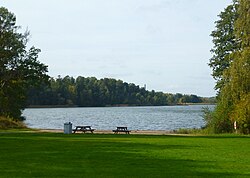Ältasjön
| Ältasjön | |
|---|---|
 | |
| Coordinates | 59°15′50″N 18°10′2″E / 59.26389°N 18.16722°E |
| Primary outflows | Ältaån |
| Catchment area | 437 ha (1,080 acres) |
| Basin countries | Sweden |
| Surface area | 73 ha (180 acres) |
| Average depth | 3.6 m (12 ft) |
| Max. depth | 5.0 m (16.4 ft) |
| Water volume | 2,710,000 m3 (96,000,000 cu ft) |
| Residence time | 1.8 years |
| Shore length1 | 5,350 m (17,550 ft) (including islands) |
| Surface elevation | 23.2 m (76 ft) |
| Islands | 2 (0.10 hectares or 0.25 acres) |
| Settlements | Stockholm, Nacka |
| References | [1][2][3] |
| 1 Shore length is not a well-defined measure. | |
Ältasjön (Swedish: "Lake of Älta") is a lake in southern Stockholm, Sweden, located north-east of Lake Flaten and named for the vicinity to the urban district Älta.
Ältasjön, of which the easternmost fourth belongs to the
The "Save Ältasjön Society", Föreningen Rädda Ältasjön (FRÄS), has been working since 1975 to improve the environmental state of the lake and promote open-air activities in and around it.[6]
Catchment area
Approximately half of the catchment area is occupied by the settlements and roads of Älta, located within Nacka, with the remaining area composed of forests, wetlands, and smaller patches of open terrain. In the northern part, forming the southern part of the open-air area, is a deciduous hardwood forest. South of the lake is the traffic route Tyresövägen receiving some 20,000 vehicles per day, and west of the road is a speedway track.[7]
Environmental influence
The lake receives about 200 kg phosphorus annually of which half comes from surface runoff and the rest is released from sediments. Surface runoff also adds 1,300 kg of nitrogen, most of which comes from the settlements of Älta. The lake used to be the recipient for poorly treated waste water from some 1,000 households today connected to the municipal sewers.[7]
Flora and fauna
In the early 20th century, phytoplankton was dominated by green algae, diatoms, and carapace flagellates with a smaller amount of cyanobacteria, a normal distribution for lakes rich in nutrients. By 2000, the biomass was almost exclusively composed of cyanobacteria, most of them non-poisonous "thin filaments" and anabacena the only species being able to fixate nitrogen. Today, the only reminder of the 1990s is the relatively frequent occurrence of the carapace flagellate Ceratium hirundinella. Zooplankton, moderate levels of rotifers and copepods, have shown insignificant variations with time.[8]
An inventory of aquatic plants in 1997 showed the western and southern parts of the lake are dominated by spiked water-milfoil and yellow water-lily, while the eastern part is dominated by common club-rush and common reed. Stratiotes aloides is found near the lake outlet.[8]
The same inventory reported 45 species/
The lake is an important stop-over for many

See also
- Geography of Stockholm
- Lakes of Sweden
Notes
- ^ Lake data from Nacka and Stockholm Municipalities varies considerably. (Compare "Vattenprogram, pp 12.1, 12.7" and "Held-Paulie".) For the purpose of the table in this article, data from "Stockholm vatten" is being used.
- ^ a b Vattenprogram, p 12.1
- ^ Vattenprogram, p 12.7
- ^ Stefan Erson (2004). "Nacka friluftsområde" (PDF) (in Swedish). City of Stockholm. Retrieved 2007-05-29. [dead link]
- ^ Ältasjön
- ^ Held-Paulie
- ^ a b Vattenprogram, p 12.3
- ^ a b c d Vattenprogram, p 12.4-12.6
References
- "Ältasjön" (in Swedish). Stockholm vatten. 2007-03-01. Archived from the original on November 29, 2007. Retrieved 2007-05-28.
- "Vattenprogram för Stockholm 2000 - Ältasjön" (PDF) (in Swedish). Stockholm vatten. Archived from the original (PDF) on 2007-09-27. Retrieved 2007-05-28.
- Birgitta Held-Paulie (2012-12-21). "Ältasjön" (in Swedish). Nacka Municipality. Retrieved 2014-02-26.
External links
- "Ältasjön i centrum" (in Swedish). Föreningen Rädda Ältasjön. 2003-08-08. Retrieved 2007-05-28. (Including photos from the lake.)

